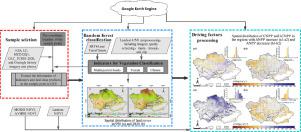Agricultural and Forest Meteorology ( IF 6.2 ) Pub Date : 2021-12-20 , DOI: 10.1016/j.agrformet.2021.108767 Saibo Li 1, 2 , Shaoyang He 2, 3

|
The variation in net primary productivity (NPP) and its controlling factors are crucial for understanding the mechanisms that maintain terrestrial ecosystem under ongoing climate and land cover change. However, such knowledge is still deficient in Central Asia where vegetation may be subjected to different drought stress. To achieve this goal, our study quantitatively explored the NPP variations and the mechanisms under different drought stress in Central Asia from 1990 to 2020 using Google Earth Engine with the Landsat datasets and environmental data. And a new method was introduced using NPP model to distinguish climate NPP (CNPP), and land cover NPP (LCNPP), affected by climate change, and land cover change, respectively. The results showed that vegetation productivity exhibited an increasing trend from 1990 to 2020, with the value of 473.61 Tg C and 522 Tg C in 1990 and 2020, respectively. The NPP in semi-arid, and dry sub-humid zones respectively increased by 12.94% and 33.78%, while NPP change in arid zones was not significant. The CNPP and LCNPP in Central Asia were -2.84×103 t C and 102.4×103 t C, respectively. In particular, land cover change significantly accumulated terrestrial productivity in the semi-arid zones, with the value of 66.44×103 t C. Climate conditions in arid and dry sub-humid zones respectively contributed 1.85×103 t C and 0.7×103 t C, but led to a decrease of 5.39×103 t C in dry sub-humid zones. NPP change in Central Asia was more sensitive to precipitation (R=0.72) than to temperature (R=-0.06) and solar radiation (R=-0.44). Additionally, the major limiting conditions in arid, and semi-arid zones both were precipitation, while the temperature was the key factor for vegetation growth in dry sub-humid ecosystems. In general, the impact of land cover change on vegetation productivity was higher than that of climate variations in Central Asia between 1990 and 2020.
中文翻译:

1990—2020年中亚地区不同干旱胁迫下净初级生产力的变化及其机制
净初级生产力(NPP)的变化及其控制因素对于理解在持续的气候和土地覆盖变化下维持陆地生态系统的机制至关重要。然而,这些知识在中亚仍然缺乏,那里的植被可能会受到不同的干旱压力。为实现这一目标,我们的研究使用谷歌地球引擎和 Landsat 数据集和环境数据,定量探索了 1990 年至 2020 年中亚不同干旱胁迫下 NPP 的变化和机制。并引入了一种新的方法,使用 NPP 模型来区分气候 NPP(CNPP)和土地覆盖 NPP(LCNPP),分别受气候变化和土地覆盖变化的影响。结果表明,1990-2020年植被生产力呈上升趋势,值为473。1990 年和 2020 年分别达到 61 Tg C 和 522 Tg C。半干旱区和亚湿润干旱区NPP分别增加12.94%和33.78%,干旱区NPP变化不显着。中亚的CNPP和LCNPP为-2.84×10分别为 3 t C 和 102.4×10 3 t C。尤其是半干旱区土地覆盖变化显着累积陆地生产力,值为66.44×10 3 t C。干旱和亚湿润干旱区气候条件分别贡献了1.85×10 3 t C和0.7×10 t C。3 t C,但导致干燥亚湿润区减少5.39×10 3 t C。中亚 NPP 变化对降水 ( R =0.72) 比对温度 ( R =-0.06) 和太阳辐射 ( R=-0.44)。此外,干旱和半干旱区的主要限制条件都是降水,而温度是干旱半湿润生态系统植被生长的关键因素。总的来说,1990-2020年中亚地区土地覆盖变化对植被生产力的影响高于气候变化。


























 京公网安备 11010802027423号
京公网安备 11010802027423号